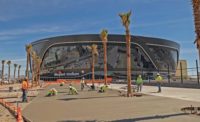One of the least-famous sections of a world-famous street is getting a $125-million makeover.
Most people think of Las Vegas Boulevard as synonymous with the Strip and its string of casinos and resorts. North of the glitter and glitz, however, the same street serves a more traditional urban environment of businesses and government buildings, while providing a major arterial through the city’s center.
This spring, the city of Las Vegas started its biggest-ever public works project—a three-year effort to improve 2.5 miles of Las Vegas Boulevard, as well as nearby Bridger Avenue and Third Street. The streets provide access to the downtown business district and the casinos along Fremont Street.
Work includes replacing underground utilities, including water, sewer, storm drains, gas and fiber optics; upgrading traffic signals, curbs, gutters and sidewalks; improving bus stops and pedestrian access, and planting 200 trees.
“We are installing smart city infrastructure to allow for new technologies to be incorporated along the corridor; widening sidewalks to make it safer for pedestrians; and laying new full-depth asphalt pavement that will improve the rideability and flow of traffic,” says Cassandra Watson-Mihelcic, engineering project manager for city of Las Vegas.
“Overall, Las Vegas Boulevard from Stewart to Sahara is getting a full makeover from top to bottom,” she says.
Underground Surprises
Watson-Mihelcic says the project, which is being managed by the city, is on schedule despite encountering what she calls “underground surprises.” Those include old sewer and drain lines, abandoned utility installations, and even forgotten traffic signals and a long-paved-over concrete section of old U.S. Highway 91.
Many of the relics date to the 1950s, when the city had a population of about 50,000 and underground mapping was less a priority than in today’s Las Vegas metro area of more than two million people.
Existing infrastructure also brought some surprises, particularly during a weekend marathon to install new storm drains. Crews came across a sewer line at an unexpected elevation and needed to make an on-the-spot decision about how to proceed.
After quick consultation, it was decided to temporarily plug the sewer line and cut a portion out of the way, allowing construction of the storm drain to push ahead, with the sewer line to be repaired later.
“This likely saved several days of closure, which would have had a major impact on the traveling public,” says Bren Wick, project manager for general contractor Las Vegas Paving.
Other options would have left traffic snarled while redirecting the sewer line or storm drain or both and fabricating components. Instead, the sewer repairs went ahead later in a more efficient fashion when everyone was prepared.
Narrow Corridor
Above ground, keeping such a large, extended project on track while minimizing disruptions poses a challenge in the tight urban environment with its narrow streets and constant traffic.
“Staging requires meticulous inventory management and organization that is not typical for this type of work,” says Wick. “We need to be able to adapt to the needs of those affected, whether it is changing work shifts weekly or even daily to accommodate a particular stakeholder’s needs.”
Collaboration with the merchants that line Las Vegas Boulevard, many of them suffering financially because of the pandemic, is a priority for project managers.
“The team reaches out to businesses prior to when they will be impacted to help ease the disruption,” Watson-Mihelcic says. “When concerns come in, we try our best to address them as soon as possible. We are able to achieve this because we have city of Las Vegas personnel, consulting firms and a member of Las Vegas Paving solely dedicated to this project.”
The work along Las Vegas Boulevard comes five years into a 20-year master plan for the greater downtown area that will make it more pedestrian and bike friendly, as well as improve streetscapes and landscaping.
Along with the new infrastructure, Las Vegas Boulevard now also boasts a splashy $6.5 million piece of public art dedicated in November. An 80-ft-high arch installed by Las Vegas Paving and sign contractor YESCO marks the Sahara Avenue border between the city and unincorporated Clark County, which governs the Strip.
Yet it’s a more modest Las Vegas Boulevard artifact that has wound up in a museum. During excavation work, crews encountered nearly century-old, remarkably pristine water pipes made of California redwood.
“It’s not something that would be considered to be ‘water quality’ in today’s day and age,” says Watson-Mihelcic, “but for us civil engineers, this was a super-cool find.”
A section of the wooden piping is destined for the Springs Preserve, a local museum that focuses on water conservation and sustainable desert living.
The Las Vegas Boulevard improvements are funded through the Southern Nevada Regional Transportation Commission, the Las Vegas Valley Water District, the city of Las Vegas and the Commission for the Las Vegas Centennial.
Work started in April and is scheduled to be complete in spring 2023, when improvements to Las Vegas Boulevard north of downtown are expected to begin.





Post a comment to this article
Report Abusive Comment